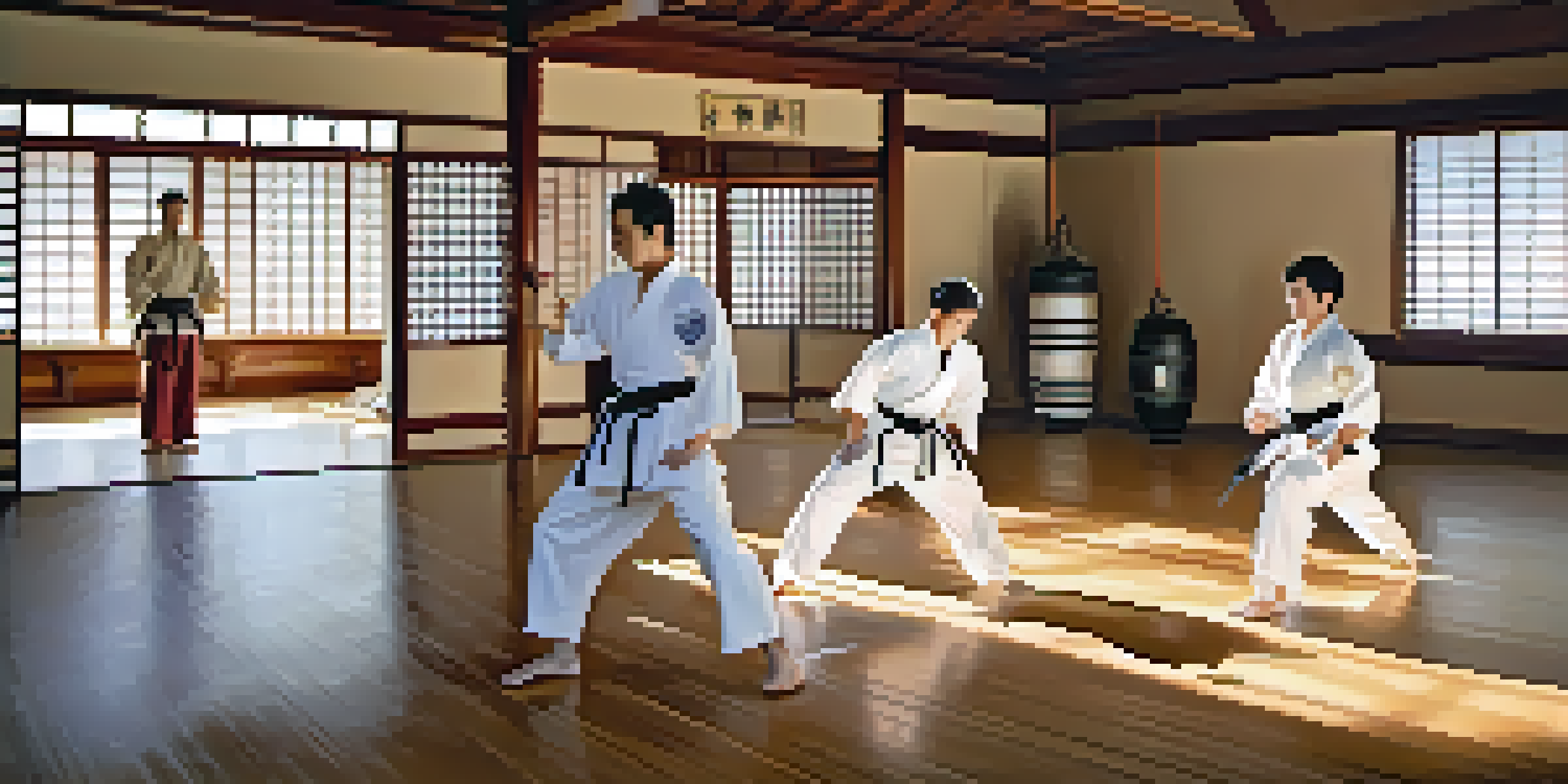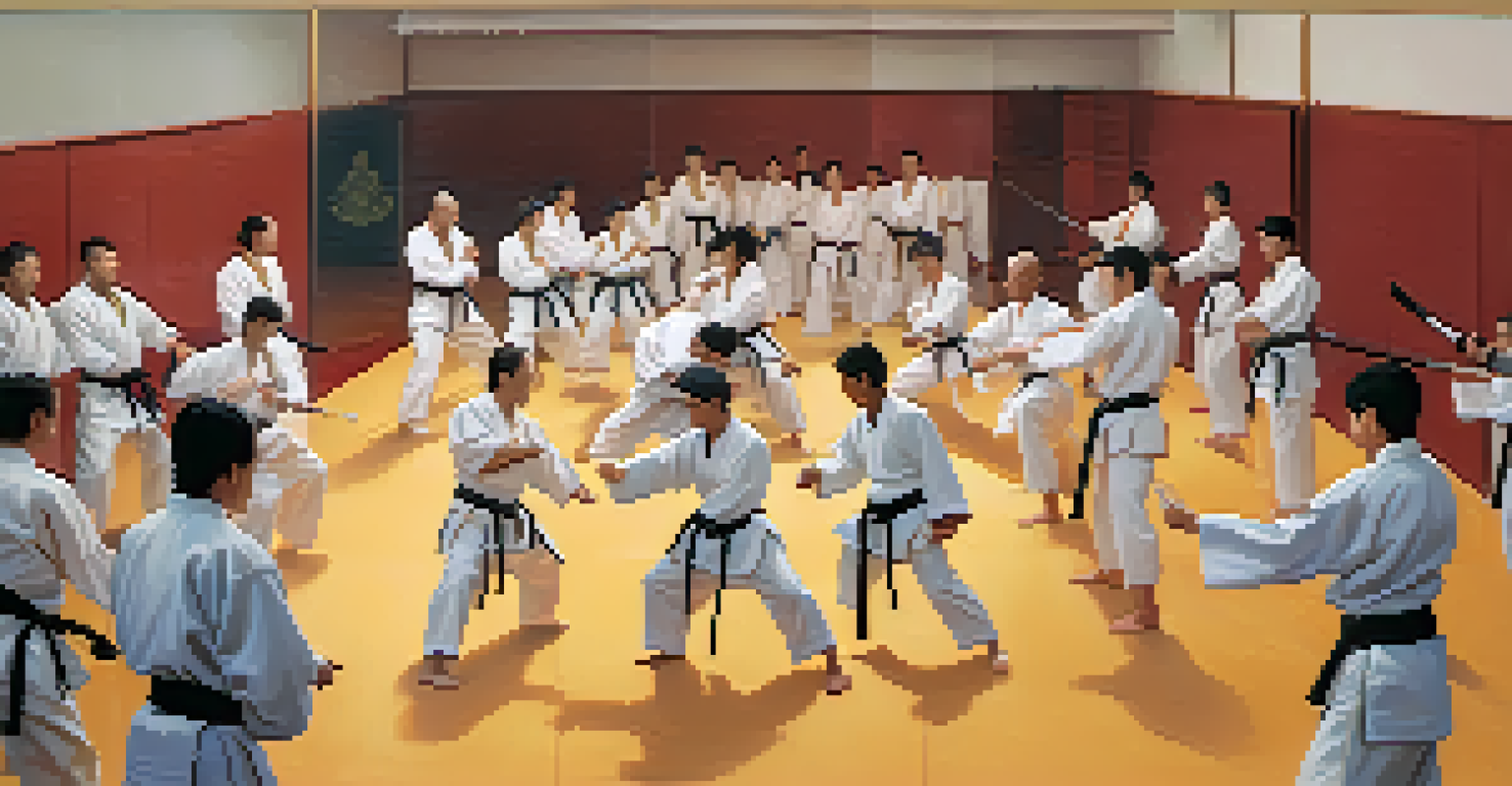Assessing Skill Levels to Reduce Injury Risks in Martial Arts

Understanding Skill Levels in Martial Arts Training
Skill levels in martial arts range from beginner to advanced, each bringing unique challenges and risks. For instance, a novice might struggle with basic techniques, while an advanced practitioner may push boundaries that can lead to injuries. Recognizing these levels is crucial for trainers to tailor their approaches to each student’s needs.
Martial arts are not about fighting; they are about building character.
Training at an appropriate skill level not only enhances learning but also minimizes the likelihood of injuries. When practitioners train within their limits, they can focus on mastering techniques without overwhelming themselves. This balance creates a safer and more effective learning environment.
Moreover, understanding skill levels helps in forming balanced training partners. Pairing a novice with an advanced practitioner can lead to frustration for both, and risk of injury for the less experienced. Thus, fostering an environment where students train with peers of similar skill levels can significantly reduce injury risks.
The Role of Proper Assessment Techniques
Proper assessment techniques are essential in identifying a student's skill level accurately. This can be achieved through observation during training sessions, performance tests, and instructor evaluations. For example, if a student consistently struggles with fundamental techniques, they may need more time before advancing.

Incorporating assessments at regular intervals helps track progress and adjust training plans accordingly. It’s similar to how a coach evaluates an athlete’s performance; regular feedback can highlight areas needing improvement. This practice not only aids in skill development but also ensures that safety remains a priority.
Recognizing Skill Levels is Key
Understanding various skill levels allows instructors to tailor training and reduce injury risks for students.
Furthermore, these assessments can uncover hidden talents or potential risks, allowing instructors to provide personalized guidance. If a student shows exceptional strength but lacks technique, instructors can focus on refining their skills to prevent injuries while harnessing their potential.
Creating a Safe Training Environment
A safe training environment is paramount in martial arts, where physical contact is often involved. Establishing clear safety protocols and guidelines can set the tone for all training sessions. For example, ensuring that all practitioners warm up properly can significantly reduce the risk of injuries.
The greatest victory is that which requires no battle.
Instructors should also emphasize the importance of communication among students. Encouraging practitioners to express their concerns or limitations fosters a culture of safety. Just like in a dance class where partners communicate their comfort levels, martial arts training thrives on mutual respect and awareness.
Additionally, utilizing appropriate protective gear can play a significant role in preventing injuries. For instance, using shin guards or mouthpieces during sparring can help cushion impacts, allowing students to train more effectively without fear of injury.
Encouraging Open Communication Among Practitioners
Open communication is vital in martial arts training, especially concerning safety and skill levels. Practitioners should feel empowered to discuss their comfort levels, concerns, or past injuries with instructors and peers. This candid dialogue can lead to tailored training experiences that prioritize safety.
For example, if a student is recovering from an injury, they should openly communicate their limitations to their partner. This way, both can adjust their practice accordingly, ensuring a safe training atmosphere. Just like in any team sport, understanding each other's capabilities is crucial to avoid accidents.
Communication Enhances Safety
Encouraging open dialogue among practitioners fosters a culture of safety and helps address individual concerns.
Encouraging feedback after sessions can also help create a culture of safety. When practitioners share their experiences, instructors can adjust training methods and address any potential hazards that may arise during sessions.
Designing a Progressive Training Curriculum
A progressive training curriculum is essential for skill development while minimizing injury risks. This approach allows practitioners to build on their skills incrementally, ensuring they master each level before advancing. For instance, a curriculum that emphasizes foundational techniques before introducing complex maneuvers can significantly reduce injury risks.
By gradually increasing the intensity and complexity of training, practitioners can adapt both physically and mentally. This method is akin to climbing a ladder; you must step on each rung before reaching the top. Skipping levels can lead to falls—in this case, injuries.
Furthermore, incorporating varied training methods can cater to different learning styles and skill levels. This diversity not only keeps training engaging but also helps practitioners develop a well-rounded skill set, further reducing the risk of injury.
Monitoring Progress and Adjusting Training Plans
Regularly monitoring progress is crucial to ensure that students are developing their skills safely. Instructors can use various tools, such as checklists or progress reports, to evaluate each student’s advancement. This ongoing evaluation helps identify when a practitioner is ready for more challenging techniques or whether they need more time at their current level.
Adjusting training plans based on these assessments is equally important. If a student is struggling with a technique, instructors can modify their training approach to focus on that specific area. Think of it as a gardener nurturing a plant; if one area is wilting, it’s essential to provide targeted care to help it thrive.
Injury Prevention is Essential
Educating students about injury risks and prevention strategies empowers them to take responsibility for their safety.
Moreover, involving students in this process—by encouraging them to set personal goals—can enhance their commitment to safety and skill development. When students take ownership of their training, they are more likely to communicate their needs, ensuring a safer training environment.
The Importance of Injury Prevention Education
Injury prevention education is vital in martial arts, as practitioners must understand the risks involved in training. Educating students about common injuries and how to avoid them can empower them to take responsibility for their safety. For instance, teaching proper falling techniques can significantly reduce the likelihood of injuries during practice.
Furthermore, incorporating injury prevention strategies into training sessions can reinforce these lessons. This might include warm-up routines, stretching exercises, and cooldown practices that help maintain physical health. Just like athletes in other sports, martial artists benefit greatly from understanding their bodies and how to care for them.

Creating a culture that prioritizes injury prevention not only benefits individual practitioners but also the martial arts community as a whole. When everyone is informed and vigilant, the overall safety and enjoyment of training improve, making martial arts a more rewarding experience.